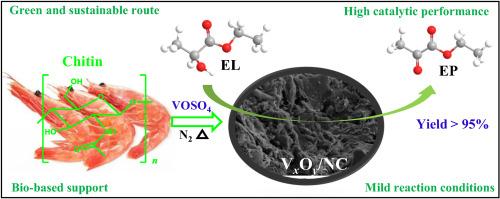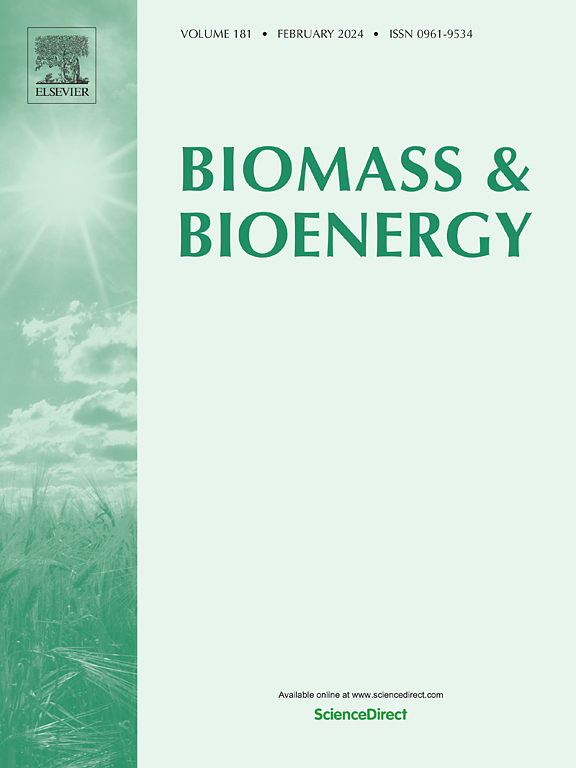甲壳素衍生的 NC 支持物 vanadia 作为乳酸乙酯氧化为丙酮酸乙酯的高效催化剂
IF 5.8
2区 生物学
Q1 AGRICULTURAL ENGINEERING
引用次数: 0
摘要
设计和合成用于催化生物质转化为高价值化学品的生物基催化剂是可持续化学领域中一条绿色且前景广阔的途径。本文以绿色廉价的生物甲壳素或壳聚糖为 N-掺杂碳(NC)前驱体,通过简单的浸渍-热解方法合成了 VxOy/NC_P 催化剂,并将其应用于乳酸乙酯(EL)到丙酮酸乙酯(EP)的有氧氧化。这些催化剂通过 XRD、N2 吸附-解吸、SEM、TEM、XPS 和 H2-TPR 进行了表征。以甲壳素作为 NC 前体(VxOy/NC_甲壳素)时,催化剂活性明显高于以壳聚糖作为 NC 前体(VxOy/NC_壳聚糖)时的催化剂活性。催化性能与表征结果之间的相关性表明,高表面积、丰富的吡啶-N 和低价钒物种(V3+ 和 V4+)在催化剂活性中发挥了重要作用。在 VxOy/NC_chitin 催化剂上,120 °C、2 小时后,EL 转化率达到 97.3%,EP 选择性达到 97.8%,并且在 5 个循环后没有出现明显的失活现象。此外,这种催化剂在将其他醇类选择性氧化为相应的醛类时也表现出很高的活性。本文章由计算机程序翻译,如有差异,请以英文原文为准。

Chitin-derived NC support vanadia as highly efficient catalyst for the oxidation of ethyl lactate to ethyl pyruvate
Designing and synthesizing bio-based catalysts for the catalytic conversion of biomass to high-value chemicals is a green and promising route in the field of sustainable chemistry. Herein, VxOy/NC_P catalyst was synthesized by a simple impregnation-pyrolysis method using green and cheap bio-chitin or chitosan as the N-doped carbon (NC) precursor and was applied to the aerobic oxidation of ethyl lactate (EL) to ethyl pyruvate (EP). These catalysts were characterized by XRD, N2 adsorption-desorption, SEM, TEM, XPS, and H2-TPR. When chitin was used as the NC precursor (VxOy/NC_chitin), the catalyst activity was significantly higher than that of chitosan as the NC precursor (VxOy/NC_chitosan). Correlation between catalytic performance and characterization results showed that the high surface area, abundant pyridinic-N, and low valence vanadium species (V3+ and V4+) played an important role in catalyst activity. A 97.3 % EL conversion with 97.8 % EP selectivity was obtained over VxOy/NC_chitin at 120 °C for 2 h, and no significant deactivation after five cycles. Moreover, this catalyst also showed a high activity in the selective oxidation of other alcohols to their corresponding aldehydes.
求助全文
通过发布文献求助,成功后即可免费获取论文全文。
去求助
来源期刊

Biomass & Bioenergy
工程技术-能源与燃料
CiteScore
11.50
自引率
3.30%
发文量
258
审稿时长
60 days
期刊介绍:
Biomass & Bioenergy is an international journal publishing original research papers and short communications, review articles and case studies on biological resources, chemical and biological processes, and biomass products for new renewable sources of energy and materials.
The scope of the journal extends to the environmental, management and economic aspects of biomass and bioenergy.
Key areas covered by the journal:
• Biomass: sources, energy crop production processes, genetic improvements, composition. Please note that research on these biomass subjects must be linked directly to bioenergy generation.
• Biological Residues: residues/rests from agricultural production, forestry and plantations (palm, sugar etc), processing industries, and municipal sources (MSW). Papers on the use of biomass residues through innovative processes/technological novelty and/or consideration of feedstock/system sustainability (or unsustainability) are welcomed. However waste treatment processes and pollution control or mitigation which are only tangentially related to bioenergy are not in the scope of the journal, as they are more suited to publications in the environmental arena. Papers that describe conventional waste streams (ie well described in existing literature) that do not empirically address ''new'' added value from the process are not suitable for submission to the journal.
• Bioenergy Processes: fermentations, thermochemical conversions, liquid and gaseous fuels, and petrochemical substitutes
• Bioenergy Utilization: direct combustion, gasification, electricity production, chemical processes, and by-product remediation
• Biomass and the Environment: carbon cycle, the net energy efficiency of bioenergy systems, assessment of sustainability, and biodiversity issues.
 求助内容:
求助内容: 应助结果提醒方式:
应助结果提醒方式:


